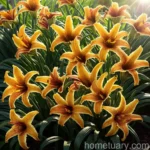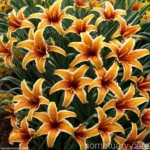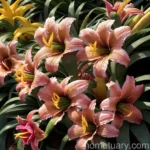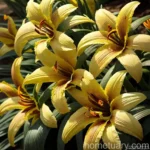Plant Scientist Blog: The Fascinating World of Daylily (Hemerocallis ‘Happy Returns’)
Welcome to the wonderful world of daylilies! In this comprehensive guide, we will delve into the captivating characteristics, cultural insights, uses, and maintenance tips for the enchanting daylily, specifically focusing on the Hemerocallis ‘Happy Returns’ variety. Whether you are a seasoned horticulturist, an avid gardener, or simply an admirer of these vibrant blooms, this blog post offers valuable insights into this beloved flower.
What is a Daylily (Hemerocallis ‘Happy Returns’)?
The daylily (Hemerocallis) is a perennial flowering plant that belongs to the family Liliaceae. As the name suggests, each flower typically lasts for just one day, but a well-established plant produces numerous buds, allowing for an extended blooming period. Hemerocallis ‘Happy Returns’ is a specific cultivar renowned for its prolific and recurrent blooming nature, making it an appealing choice for garden enthusiasts and landscapers alike.
Key Takeaways – Daylily (Hemerocallis ‘Happy Returns’)
Before we delve into the details, let’s break down the essential aspects of the Hemerocallis ‘Happy Returns’:
- Scientific Name: Hemerocallis ‘Happy Returns’
- Family: Liliaceae
- Common Name: Daylily
- Blooms: Prolific and recurrent
- Uses: Ornamental, landscaping, and companion planting
- Distinctive Feature: Remarkably resilient and easy to cultivate
- Overall Appeal: Adds vibrant color and visual interest to various outdoor settings
- Special Note: This variety is revered for its extended blooming period and exceptional resilience.
Now that we have a brief overview, let’s explore the detailed cultural insights, uses, and maintenance guidelines for the Hemerocallis ‘Happy Returns’.
Hemerocallis ‘Happy Returns’ Plant Profile
Daylily Characteristics
The Hemerocallis ‘Happy Returns’ is celebrated for its numerous distinctive characteristics, including:
- Repeat Blooms: This variety is known for its propensity to produce multiple blooms throughout the growing season. The vibrant yellow flowers are a delightful sight in gardens and landscapes.
- Resilience: Hemerocallis ‘Happy Returns’ is remarkably resilient, enduring diverse climatic conditions and soil types. Its robust nature makes it an excellent choice for novice and experienced gardeners alike.
- Adaptability: This daylily variety thrives in various environments, whether planted in full sun or partial shade. Its adaptability is a testament to its versatility in diverse settings.
- Foliage: The foliage of Hemerocallis ‘Happy Returns’ is equally striking, with elongated, arching leaves contributing to the overall visual appeal of the plant.
Hemerocallis ‘Happy Returns’ Overview
In essence, Hemerocallis ‘Happy Returns’ stands out as a charming and resilient cultivar that brings a cheerful burst of color to gardens and landscapes. Its recurring blooms, adaptability, and overall vigor make it an attractive choice for horticultural enthusiasts and landscape designers.
Daylily (Hemerocallis ‘Happy Returns’) Care Guide
Cultivating and caring for Hemerocallis ‘Happy Returns’ can be a rewarding experience when armed with the right knowledge and techniques. Let’s delve into the essential care guidelines for this captivating daylily variety:
Water
Proper hydration is crucial for the health and vitality of Hemerocallis ‘Happy Returns’. Here are some key considerations for watering this plant:
- Regular Watering: While daylilies are relatively drought-tolerant once established, consistent moisture is essential for optimal growth and blooming. Water deeply to encourage healthy root development.
- Morning Watering: Aim to water daylilies in the morning to allow foliage and flowers to dry out during the day, reducing the risk of fungal diseases.
- Mulching: Applying a layer of mulch around the base of the plants helps to retain soil moisture and regulate soil temperature, promoting overall plant health.
Sunlight
The appropriate amount of sunlight plays a significant role in the growth and blooming of Hemerocallis ‘Happy Returns’. Consider the following sunlight requirements for this daylily variety:
- Full Sun: Hemerocallis ‘Happy Returns’ thrives in full sun conditions, typically requiring a minimum of 6 hours of direct sunlight daily. Placing them in a sunny location ensures robust growth and abundant blooming.
- Partial Shade: While these daylilies prefer full sun, they can also tolerate partial shade, especially in regions with intense afternoon sun. Providing some afternoon shade can prevent excessive wilting in hot climates.
Fertilizer
Supplemental fertilization can contribute to the overall health and vigor of Hemerocallis ‘Happy Returns’. Here’s a basic fertilizer regimen for optimal growth:
- Balanced Fertilizer: Apply a balanced, slow-release fertilizer in spring as new growth emerges. Opt for a formulation with a balanced NPK ratio to support healthy foliage and flower production.
- Additional Applications: If the plants show signs of nutrient deficiency or exhibit lackluster blooms, a light application of fertilizer during the growing season can provide the necessary nutrients.
Soil
The right soil conditions are essential for ensuring the well-being of Hemerocallis ‘Happy Returns’. Consider the following soil preferences for this daylily variety:
- Well-Draining Soil: Daylilies thrive in well-draining, loamy soil that allows excess moisture to percolate easily. Amending heavy clay soils with organic matter can improve drainage and aeration.
- Soil pH: Hemerocallis ‘Happy Returns’ thrives in slightly acidic to slightly alkaline soil, with a pH range of 6.0 to 7.5 being ideal. Conduct a soil test to assess the pH and make necessary amendments.
Pruning
Regular pruning and grooming are beneficial for maintaining the overall appearance and vigor of Hemerocallis ‘Happy Returns’. Here are some key pruning considerations for this daylily variety:
- Spent Bloom Removal: Deadheading spent blooms promotes continuous flowering and prevents the plant from expending energy on seed production.
- Foliage Cleanup: Trim back any discolored or damaged foliage throughout the growing season to maintain a tidy appearance and minimize disease potential.
Propagation
Expanding your collection of Hemerocallis ‘Happy Returns’ can be achieved through simple propagation methods. Consider the following propagation techniques for this particular daylily variety:
- Division: Divide mature clumps of Hemerocallis ‘Happy Returns’ every few years to rejuvenate the plants and create new specimens. Dividing in early spring or after flowering allows the divided sections to establish quickly.
Container Popularity
While Hemerocallis ‘Happy Returns’ thrives in garden beds, it’s also a popular choice for container cultivation. Here are some insights into its container gardening appeal:
- Space-Saving Option: Container-grown daylilies are ideal for individuals with limited garden space or those looking to add vibrant blooms to patios, balconies, or terraces.
- Portability: Containers allow for easy placement and rearrangement, enabling gardeners to showcase the beauty of Hemerocallis ‘Happy Returns’ in various outdoor settings.
Hemerocallis ‘Happy Returns’ in Landscaping
The vibrant blooms and adaptability of Hemerocallis ‘Happy Returns’ make it a valuable addition to landscaping projects. Consider the following uses and landscaping insights for this captivating daylily variety:
Companion Plants
Pairing Hemerocallis ‘Happy Returns’ with suitable companion plants enhances its visual impact and overall appeal in mixed borders and landscape designs. Here are some ideal companions:
- Perennials: Partner with flowering perennials such as coneflowers (Echinacea), black-eyed Susans (Rudbeckia), and bee balms (Monarda) for a vibrant display throughout the growing season.
- Grasses: Mixing ornamental grasses like fountain grass (Pennisetum) and switchgrass (Panicum) with Hemerocallis ‘Happy Returns’ adds textural interest and creates dynamic visual compositions.
Landscaping Ideas
Incorporating Hemerocallis ‘Happy Returns’ into landscaping designs offers limitless creative possibilities. Here are some landscaping ideas for utilizing this vibrant daylily variety:
- Mass Planting: Planting large drifts or clusters of Hemerocallis ‘Happy Returns’ creates a visually striking display, especially when combined with complementary foliage plants for added contrast.
- Border Planting: Using daylilies as a border plant along pathways or garden beds adds a pop of color and creates a cohesive, neat appearance in the landscape.
Hemerocallis ‘Happy Returns’ Blooms
The captivating blooms of Hemerocallis ‘Happy Returns’ are a focal point in any garden or landscape setting. Here are some insights into its blooming habits and visual appeal:
Recurrent Blooms
One of the most notable features of Hemerocallis ‘Happy Returns’ is its propensity to produce recurrent blooms throughout the growing season. The vibrant yellow flowers infuse outdoor spaces with cheerful color and charm, contributing to a lively and dynamic landscape.
Color Variations
The blooms of Hemerocallis ‘Happy Returns’ exhibit a consistent and vibrant yellow hue, creating a striking visual impact. The uniform coloration of the blooms adds coherence and brightness to any planting scheme or landscape design.
Hemerocallis ‘Happy Returns’ Diseases and Pests
Proactively managing and addressing potential diseases and pests is crucial for maintaining the health and vitality of Hemerocallis ‘Happy Returns’.
Common Diseases
While daylilies are generally robust, they can occasionally encounter certain diseases. Be mindful of the following common diseases that may affect Hemerocallis ‘Happy Returns’:
- Leaf Spot: Fungal leaf spot diseases can occur, leading to discolored spots on the foliage. Provide adequate air circulation and avoid overhead watering to reduce the risk of leaf spot.
Disease Diagnosis
Detecting and diagnosing potential diseases early is key to implementing effective control measures. Consider the following tips for disease diagnosis:
- Monitoring Foliage: Regularly inspect the foliage for any signs of discoloration, spots, or abnormal growth. Early detection allows for timely intervention and treatment to prevent disease spread.
Common Pests
While daylilies are relatively resistant to pests, they can occasionally attract certain unwanted visitors. Be vigilant for the following common pests that may affect Hemerocallis ‘Happy Returns’:
- Aphids: These tiny, sap-sucking insects can infest the tender growth of daylilies, leading to distorted foliage and reduced vigor. Monitor for aphid populations and employ natural predators or targeted treatments if necessary.
Botanist’s Tips
Drawing from expert botanical insights can offer valuable guidance for cultivating and appreciating Hemerocallis ‘Happy Returns’.
Fun Facts
Uncover some fascinating and intriguing fun facts about Hemerocallis ‘Happy Returns’ to deepen your appreciation for this beloved daylily variety:
- Historical Significance: Daylilies have a rich history, with references to their cultivation dating back centuries. They have been revered in various cultures for their beauty and symbolism.
- Cultural Significance: In some traditions, daylilies symbolize renewal and rebirth, making them a popular choice for celebratory ceremonies and garden plantings.
Links to External Resources
For further exploration and in-depth information, consider the following external resources:
Conclusion
In conclusion, Hemerocallis ‘Happy Returns’ stands out as a resilient, vibrant, and visually captivating daylily variety that holds immense appeal for gardeners, landscapers, and plant enthusiasts. Whether incorporated into mixed borders, mass plantings, or container gardens, this daylily introduces cheerful color and enduring beauty to outdoor spaces. With its recurrent blooms, adaptability, and overall vigor, Hemerocallis ‘Happy Returns’ represents a delightful addition to diverse horticultural and landscape endeavors.
By understanding its cultural preferences, maintenance needs, and landscaping potential, we can fully embrace the charm and allure of Hemerocallis ‘Happy Returns’ in our outdoor settings. Here’s to celebrating the enduring beauty and resilience of this remarkable daylily variety!















